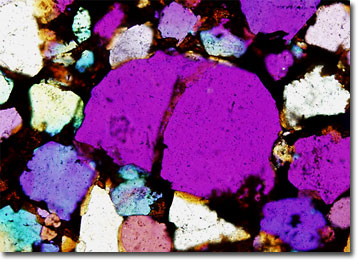Polarized Light Microscopy Digital Image Gallery
Banded Sandstone
Sandstone is a type of sedimentary rock that consists chiefly of quartz particles that are less than two millimeters in diameter. Extremely common, the only sedimentary rock more prevalent than sandstone is shale, which is comprised of even finer-grained sediments.

In a textural sense, sandstones are only comprised of two components: sand-sized particles of matter and interstitial space. In recently formed sandstones, the space between the grains is often empty, but in older varieties of the rock a cementing material, such as lime, silica, or iron oxide, is characteristically present. The relative hardness and durability of the rock is primarily determined by the nature of the cementing agent. The presence of silica typically results in the hardest specimens and it is, therefore, this variety of sandstone that is most commonly utilized as a building stone. Softer forms of the rock are more frequently crushed for use as sand.
The expansive sandstone landscapes found in the western United States are some of the most breathtaking in the world. The impressive spiraling monoliths, jagged cliffs, and deep canyons in the region are awe inspiring in their magnificence, drawing tens of thousands of hikers and tourists to the area each year. Similar to a sunset, the colors found in these sandstone formations commonly feature deep reds, oranges, and yellows. In some locations, these colors alternate in beautiful banded patterns, which resulted from rapid changes in the surrounding environment. Splendid examples of banded sandstone can be viewed in Nevada’s Red Rock Canyon and Nine Mile Canyon in Utah. Sometimes utilized as a gemrock, banded sandstone is occasionally referred to as wonderstone in commercial circles.
